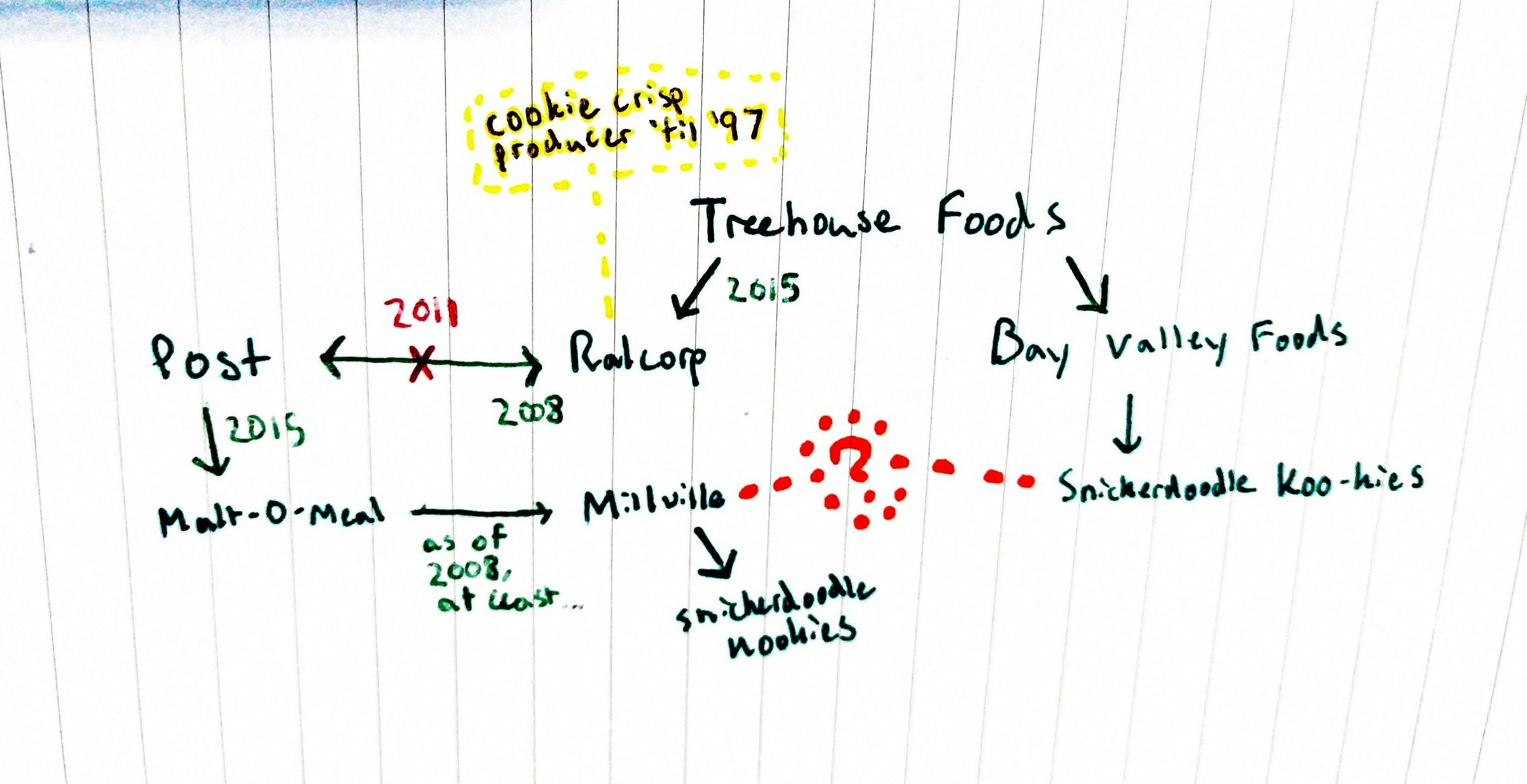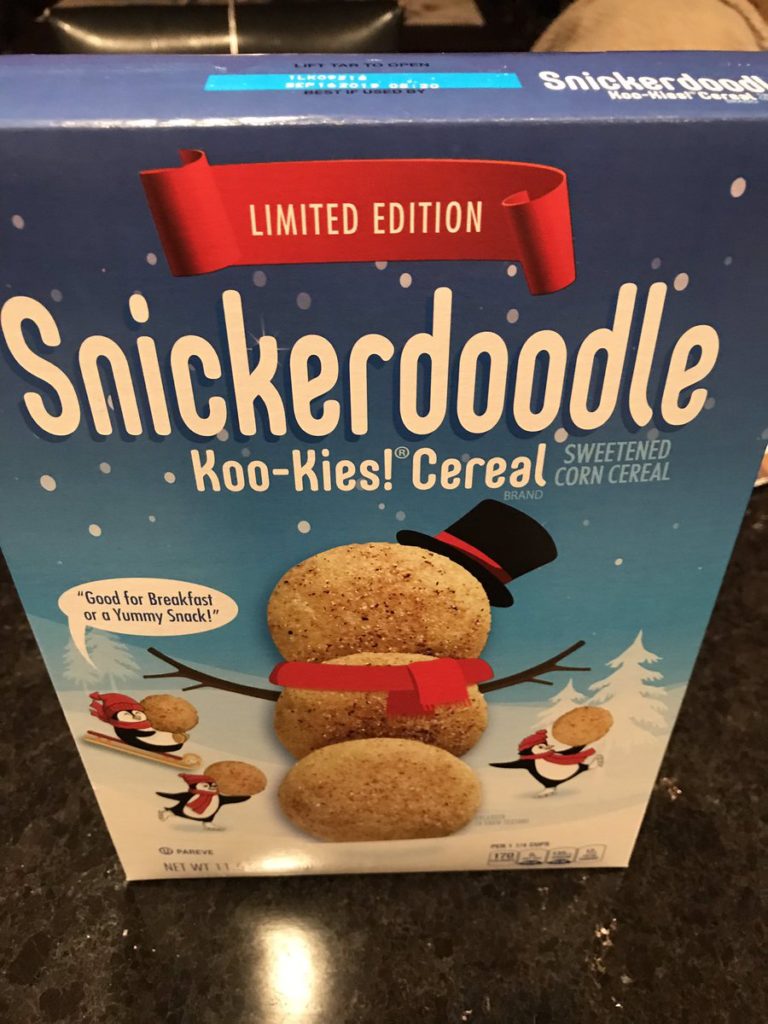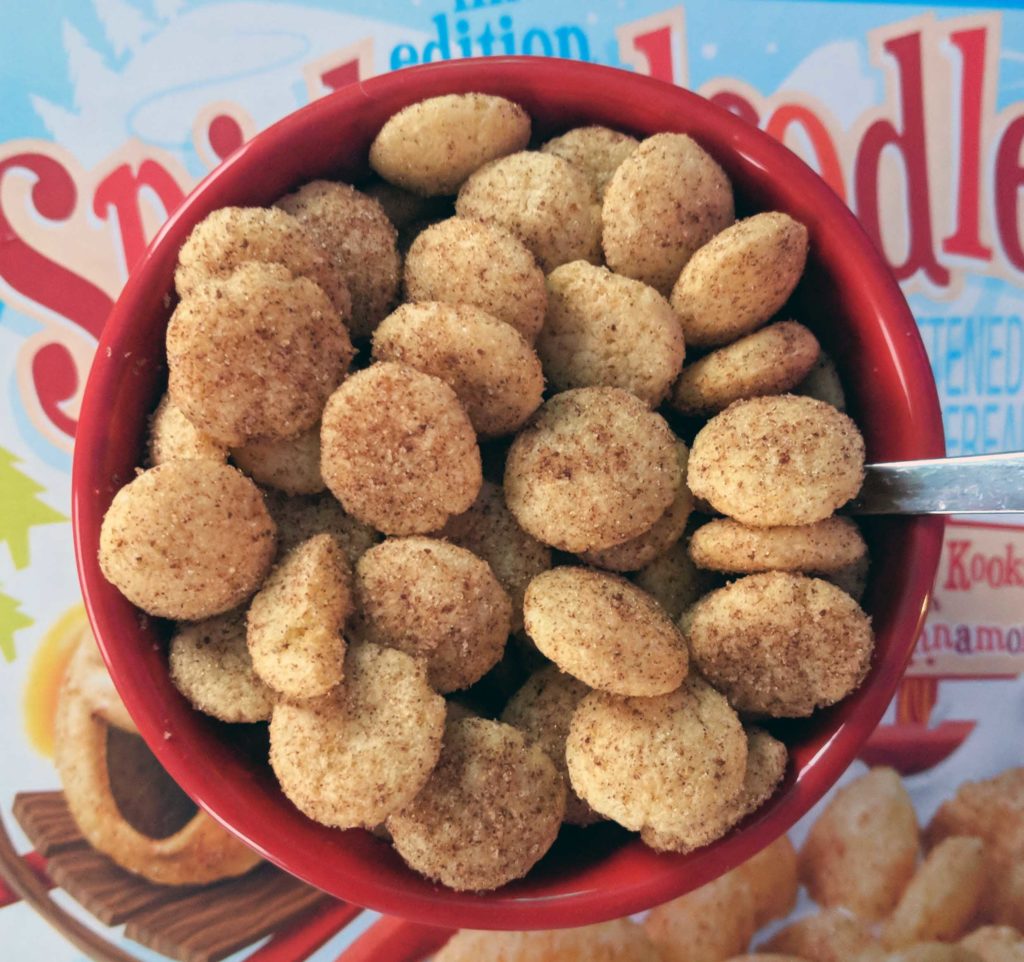Consider this a gentle warning: no matter how much you like digging into a bowl of cinnamon sweetness, don’t bother digging deep into its origins.
Because as I’ve learned, you risk getting tangled in the strings of a merry marionette show starring corporate puppet brands, shrouded timelines, and eye-dehydrating confusion.
It all started when the above photo of Limited Edition Snickerdoodle Koo-Kies, produced by Bay Valley Foods, was tweeted to me by reader Fabo. It instantly caught my curiosity, and not just because of the bizarrely lifeless and questionably adorned box art (why does the penguin need a speech bubble and quotation marks to Regurgitate His Vapid Claim?).
See, those with a larger-than-penguin-sized memory will doubtlessly wonder how, why, and how dare this cereal exists when Millville and Aldi have already been making big headlines and waistlines with their Snickerdoodle Kookies cereal. Surely this doppelgänger, with its unheimlich hyphenation, must be about as authentic as a mall Santa, right?
Not content with all these questions, and particularly dissatisfied that I likely won’t get to try these Koo…pause for emphasis…Kies myself (they were found in a Pennsylvania Giant Foods), I took my journalistic wagon to the information super highway. Because if I can’t taste Snickerdoodle Koo-Kies, you’d better believe I’m still going to understand its genetic genesis.
My previous cursory research on Millville turned up only theories, some anecdotally linking them to General Mills and others referencing old product recall notices to link the brand to Malt-O-Meal. And that claim seemed to hold milk at first, with even Wikipedia noting it as a subsidiary of MOM Brands.
But then Bay Valley Foods complicated things, as I was unable to find an immediate connection between them and Malt-O-Meal, or even Post, who bought MOM in 2015 for a particularly family-sized cereal money bag of $1.15 billion. It seemed far too unlikely that two companies would independently dream up the same ho-ho-homophonic cereal, so there had to be a missing link.
And I should’ve suspected the answer would require elven wisdom. After a hollow search through blasé-ly templated corporate homepages never intended for plebeians like me, I came upon an interesting footnote in the history of TreeHouse Foods, the parent company of Bay Valley Foods whose leadership once manned the now-Kelloggian Keebler brand—which probably isn’t where TreeHouse Foods got its name even though my Fudge Striped brain imagines otherwise.
In late 2015—less than a year after Post’s MOM purchase—TreeHouse Foods acquired Ralcorp, itself a subsidiary of ConAgra Foods. If this sets off excited hunger pangs, it should: Ralcorp was once known as Ralston Purina, maker of pre-General Mills-sale Cookie Crisp(!!) and pet food. Ralcorp bought out Post in 2007, but split with the property, and presumably all its Waffle Crisped subsidiaries, in 2011.
Back to the post-Post era of 2015, it turns out TreeHouse Foods actually beat out Post in its attempt to buy out its owner of 4 years prior. So when TreeHouse Foods acquired Ralcorp—and this is the big cognitive, ultimately unconfirmed leap I’ve had to make—it seems they inherited not the Millville brand, which MOM Brands presumably held privately through the Post-Ralcorp-TreeHouse kerfuffle, but the connections that naturally come with the intimate relationship Post and Ralcorp have had.

A narrow window into the unkempt garden of madness.
These shared connections are no empty guess: LinkedIn reveals that many Ralcorp employees migrated to Post, as Ralcorp still held Post company share through part of 2012. And one such employee’s history confirms that Post & Ralcorp co-packed (and still do) product under private labels, a process that involves “ manufacturing similar products to be sold under a different name for a client,” according to that earlier Millville mythologist’s contact at General Mills.
So for the three of you still with me, the conclusion I came to is about as satisfying as a 90%-scratched itch: that Millville (a.k.a. MOM Brands & Post) and Bay Valley Foods (a.k.a. Ralcorp & TreeHouse Foods) are likely co-packing the Snickerdoodle Koo(-)kies, perhaps across the remaining sinews of a long-soggy corporate partnership.
Whose original idea the fantastic Kookies was remains unclear—it could be either party or a nebulous co-packer—but without a final answer, I should at least be allowed to imagine that Santa Claus himself slipped the idea into the sleeping mind of some CEO, nestling the nugget of a concept somewhere between the first and second act of dancing gumdrops.
It’s an idea so sweet it could make me cry, but rest assured: after all that research, there definitely are a few dry ideas in the house.
Thanks again to Fabo for the picture and implied quest through corporate ancestry. If anyone reading this finds holes in my theory or has insight to add, feel free to reach out and I can amend this Post (err, post: Freudian slip) appropriately.







this looks like my tries to get the “real” company behind the store brands, everytime an interesting cereal comes out and looks a waaaay too good for just a knock-off 😀
This post is btw the reason i know you love cereal as much as i do. I mean seriously… who the hell is going to investigate hours just to get a conclusion about the producer of some cereal xD
btw loved to see “unheimlich” in your post 😀
CHEERS!
Between your diagram and the quotes on the speech bubble I’m going to be in a good mood all day. Love this!
This is the most hard hitting cereal related article I have ever seen. Well done!